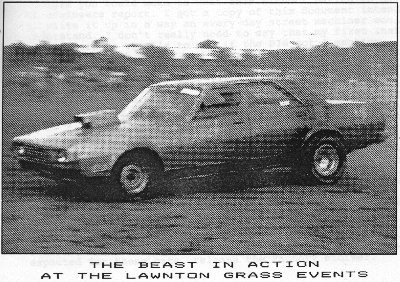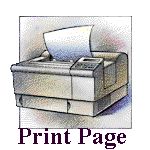Leyland P76 Owners 2003 |
Building a Drag Car |
P-76 Drag Car - THE BEAST
By G Rogerson

- G'day P-76'ers, Rogo here.
- For some months now, my daughter's boyfriend, MICK DIXON has been building a P-76 Drag Car - THE BEAST!
- A few bits, pieces and I supplied the car. Most of the work and money by Mick, and up to now, we have been doing pretty well.
- After a lot of hard work getting the P ready for racing, we finally made it to Willowbank Drag strip, which is 1 1/2 hours drive away from my place. After lining up in the staging lanes for about an hour, Mick drove the P onto the grid. The car looked mean with its undercoat grey paint, and splodges of black here and there (paint job by Mick!). Even the announcer commented on it, as no one had ever seen one at the drags before!
- After Mick had smoked the tyres a bit, he sat on the line waiting for the lights to change to green. He was up against a mate of his, in a 2-door Valiant. The lights changed, and they WERE OFF! The Valiant missed and coughed a lot, and Mick shot away. He beat the Valiant, even though the P was stuck in second gear. I don't know what the time was, but I was able to film it by walking down the side of the track with the cars.
- The next run about an hour later, as soon as Mick rolled onto the grid, down came the rain! So that was the end of the day.
- During the next couple of months, we made four more trips, and it rained every time we went. Sometimes, we didn't even get the Beast off the trailer. In between trips, Mick spent more and more money on the P, trying to improve its performance.
- At long last, we picked a fine weekend, and managed to get another run. This time, we did pretty well, although we still had a bit of trouble with the gearbox (a Borg-Warner 35!), which brings me to the reason I'm writing this.
- After a few more trips, and a lot of funny things happening to us (which is another story!), Mick finally decided that the gearbox was not strong enough for Drag racing (we had already been told this!), and he thought that he would try out a Ford gearbox, and ended up with a F.M.X.

- Get an adapter plate for B-W 35 to F.M.X. or C4.
- Get a gearbox; an F.M.X. will cost $350.00 to $450.00, where a C4 will cost $150.00 to $250.00. A C4 is not as strong as the F.M.X, but it is certainly a lot stronger that a B-W 35!
- A small piece has to be cut out of the bell housing, to accommodate the P-76 starter motor gear and shield.
- The inside of the bell housing requires minor grinding, to clear the bolts holding the adapter plate to the motor.
- Because a 3/8 adapter plate is used between the motor and the gearbox, the torque converter must have spacers welded to it at different hole centers, to be able to be matched to the P-76 flex-plate and ring-gear assembly, The locating spigot on the converter must be lengthened, and it is recommended that this be done by a professional autobox person, as the balance may easily be put out, thereby causing excessive vibration, and seal wear. This will all cost about $100.00.
- A tall-shaft for the particular gearbox must be used, which is shortened, and fitted with a Ford 21R yoke and universal in the rear-end. The shaft must be re-balanced, and on my car, the F.M.X. Tail-shaft ended up 5mm shorter than originally.
- A cable shifter is required to replace the standard shifter. The reason for this is that there is much less room between the transmission tunnel and the gearbox. Make sure that the correct type of shifter is bought for the gearbox that you use. Most after-market companies make shifters for a C4, but finding an F.M.X. may be difficult. A C4 bracket can be modified by opening the holes in the bracket to hold the cable to the pan bolts on the F.M.X.
- A do-it-yourself adapter plate can be made from 3/8 in plate steel, cut into a semi circle. The inner series of holes suits the motor, and the outer series of holes suits the gearbox. The outside diameter of the plate is determined by the largest diameter of the bell housing of the F.M.X. or C4. The inside diameter is determined by the smallest diameter of the back flange of the motor, making sure that the plate does not interfere with the ring-gear or the torque converter. The bolts from the motor to adapter plate start from directly above the starter motor, and go around the rest of the motor (see diagram!)
- The transmission tunnel above the front universal joint has to be raised, as the front universal will now rub the floor, The cross-member does NOT need to be changed, but the rear engine mount does, to suit the box that you have chosen.
- The gearbox may be fitted with one of three shift kits: - No. 1: For definite shifts, and towing - extends gearbox life. Cost 0f approximately $70.00. No. 2: Street and strip use for hard shifts - approximately No. 3 Full manual kit (i.e. select 2nd, and the car will try to take off in 2nd!) Cost about $150.00 and not available for street use.
- A "High-stall" converter may be made while the converter is in for modifications. "High-stall" means that if the converter is made to 2500 r.p.m., the idle is able to be picked up to 2500 r.p.m., and the take-off is hard and fast. This will cost approximately $250.00.
- Throw away the standard radiator transmission "cooler", and get a purpose built item for about $85.00.
- Well, I hope that you understand all of that, and if you have any queries, Mick will be able to put you right. Just give me a phone. I would like to thank Mick for his help in writing this, especially as he is a Ford man, and not a P-man.
- We hope to see you at Willowbank someday Rogo.
This site is hosted on
Freeservers  Reliable, Free Web Hosting |
Last updated Feb, 2007 |
This web site may contain Copyright material If you find any problems with the site, please email the Web Editor  |
